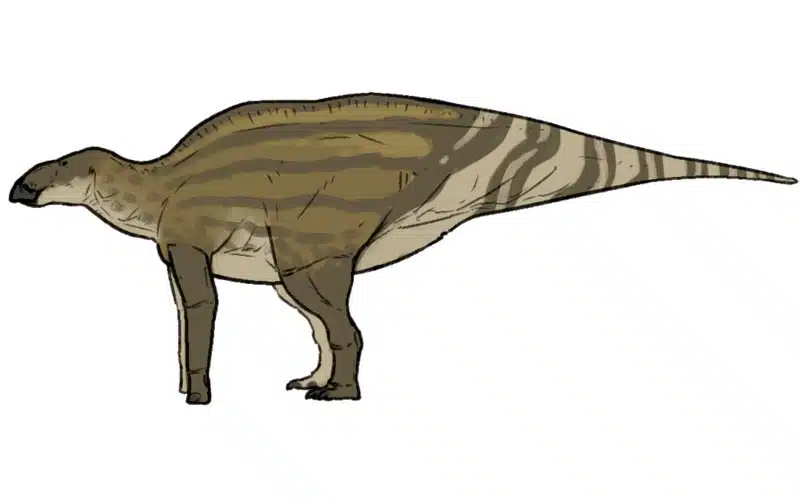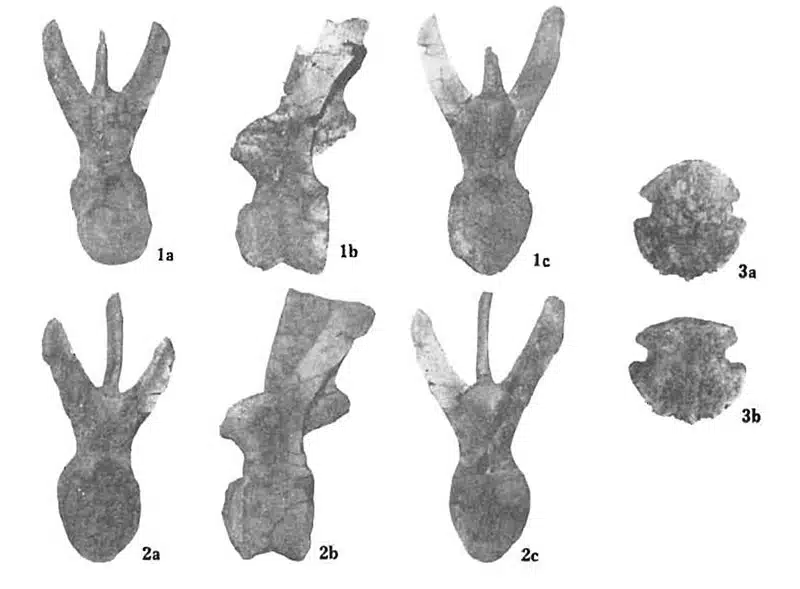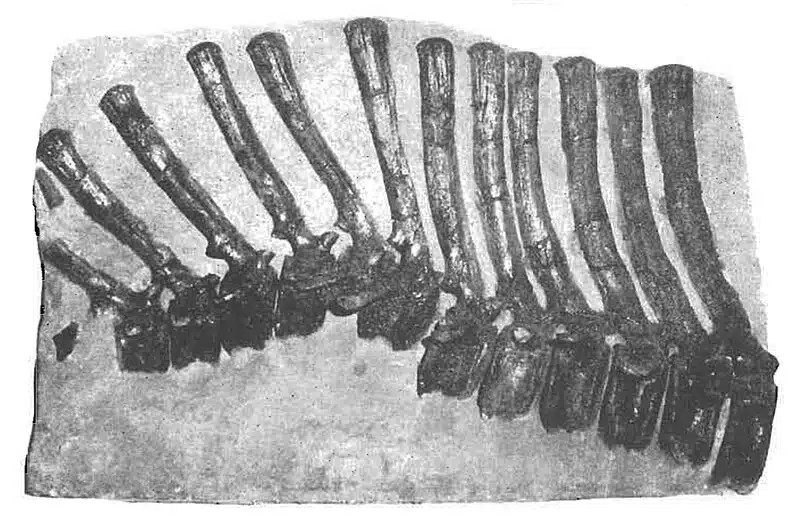Venturing back to the Late Cretaceous Era, we uncover the story of Barsboldia, a fascinating dinosaur that roamed the earth millions of years ago. Picture the vast, rugged landscapes of what is now the Gobi Desert, and imagine these majestic creatures thriving in such a world. Their tale is not just a relic of the past; it offers us a window into an era that has long since vanished, but which continues to captivate our imagination and curiosity.
In this journey, we explore Barsboldia in all its wonder. Named in honor of renowned Mongolian paleontologist Rinchen Barsbold, this ornithopod challenges our understanding of the Cretaceous world. Its discovery in the Nemegt Formation by a Polish-Mongolian expedition in 1970 opened a new chapter in paleontology, broadening our knowledge of the diverse and vibrant ecosystem of the Late Cretaceous.
Barsboldia Key Facts
| Keyword | Fact |
|---|---|
| Pronunciation | Barz-bol-de-uh |
| Meaning of name | “of Barsbold” |
| Group | Ornithopoda |
| Type Species | Barsboldia sicinskii |
| Diet | Herbivore |
| When it Lived | 72.1 to 66.0 MYA |
| Period | Late Cretaceous |
| Epoch | Maastrichtian |
| Length | 39.0 to 46.0 feet |
| Height | 13.0 feet |
| Weight | Approximately 5.5 tons |
| Mobility | Bipedal/Quadrupedal |
| First Discovery | 1970 by Polish-Mongolian Expedition |
| Described by | 1981 by Teresa Maryańska and Halszka Osmólska |
| Holotype | ZPAL MgD-1/110 |
| Location of first find | Nemegt Formation, Gobi Desert, Mongolia |
Barsboldia Origins, Taxonomy, and Timeline
The name Barsboldia, paying homage to Rinchen Barsbold, is quite fitting for this ornithopod, belonging to the family of Hadrosauridae. This dinosaur was first classified as Barsboldia sicinskii, and its herbivorous diet marked it as a gentle giant of its time.

The timeline of Barsboldia is particularly interesting. It lived during the Late Cretaceous Period, more specifically in the Maastrichtian. This timeline, ranging from approximately 72.1 to 66.0 million years ago, situates Barsboldia towards the end of the age of non-avian dinosaurs, a time of significant evolutionary changes and diversification.
Discovery & Fossil Evidence
Barsboldia, a majestic hadrosaur, was first discovered in the Gobi Desert, Mongolia, by a Polish-Mongolian Expedition in 1970. This remarkable discovery in the Nemegt Formation unveiled a creature that roamed the earth during the Late Cretaceous Period. The fossils found, including bones from different parts of the body, offered a glimpse into the life and structure of this colossal dinosaur.
The most striking feature of Barsboldia lies in its neural spines. These spines, particularly prominent over the hips, are among the tallest observed in hadrosaurs, surpassed only by those of Hypacrosaurus altispinus. Interestingly, the tips of some of these spines, especially in the tail region, are club-shaped, which could indicate age-related characteristics.
- Barsboldia dorsals & pedal ungual
- Caudal vertebrae
- Barsboldia vertebrae
- Barsboldia vertebrae
- Barsboldia left ilium & rib
Barsboldia Size and Description
Barsboldia was a notable hadrosaur, distinguished by its considerable size and unique physical features. With tall neural spines and a robust build, it was a commanding presence in its habitat.
Originally estimated to be about 33.0 feet in length and weighing approximately 5.5 tons, recent studies have suggested Barsboldia might have been even larger. Measurements of its tibia (the shinbone) indicate a possible length of 39.0 to 46.0 feet, placing it among the largest hadrosaurs, comparable to Shantungosaurus and Magnapaulia.
Video of Dino Drawing
Contemporary Dinosaurs
In the Maastrichtian (Late Cretaceous), the majestic Barsboldia was not a solitary figure on the Cretaceous landscape. Its existence was intertwined with an array of fascinating contemporaries, each playing a role in the intricate tapestry of life at that time.
Adasaurus, a smaller theropod, shared this ancient world with Barsboldia. While its diminutive stature compared to the herbivorous Barsboldia implies a lack of direct competition, these two creatures likely navigated a complex web of ecological interactions. Adasaurus, a potential predator of smaller animals, might have crossed paths with Barsboldia in a dance of coexistence, where one’s presence subtly influenced the other’s survival strategies.
Anserimimus, another contemporary, presents a fascinating contrast. Similar in diet to Barsboldia, this fleet-footed herbivore could have competed for resources. Their interactions, though indirect, speak volumes about the dynamics of survival where food and territory were coveted commodities. The coexistence of these two herbivores exemplifies the diverse strategies life employed to thrive.
Bagaraatan, a versatile and potentially carnivorous dinosaur, roamed these ancient plains alongside Barsboldia. The possible predator-prey dynamic between them adds an intriguing layer to our understanding of Barsboldia’s life. Vigilant and robust, Barsboldia might have been a formidable opponent for a predator like Bagaraatan, depicting a classic tale of survival and adaptation.
The towering Deinocheirus, possibly one of the largest ornithomimosaurs, shared the epoch with Barsboldia. Their sizes, seemingly on par, paint a picture of a landscape dominated by giants. While not direct competitors due to differing diets, their simultaneous existence underlines the diverse forms life took in this ancient world.
Barsboldia in its Natural Habitat

During the Late Cretaceous, Barsboldia’s home was a far cry from today’s Gobi Desert. Instead, it was a lush, green world, teeming with life and rich in vegetation. This bountiful environment provided a diverse buffet for a herbivore like Barsboldia.
The flora of this time was varied, offering Barsboldia ample food choices. From low-lying ferns to possibly higher-reaching leaves, its diet was as diverse as the plants around it. The landscape itself was an intricate tapestry of river valleys, floodplains, and forests, setting the stage for a thriving ecosystem.
In this vibrant ecosystem, Barsboldia played its role amidst a diverse cast of contemporaries. Its feeding habits could have shaped the vegetation patterns. Moreover, its interactions with other species added to the dynamic nature of the Cretaceous ecosystem.
Frequently Asked Questions
Barsboldia is named in honor of Rinchen Barsbold, a prominent Mongolian paleontologist.
This dinosaur thrived during the Maastrichtian Epoch of the Late Cretaceous Period, around 72.1 to 66.0 million years ago.
The initial fossils were unearthed in the Nemegt Formation, Gobi Desert, Mongolia.
It is an ornithopod, belonging to the Hadrosauridae.
Teresa Maryańska and Halszka Osmólska described it in 1981.
Sources
The information in this article is based on various sources, drawing on scientific research, fossil evidence, and expert analysis. The aim is to provide a comprehensive and accurate overview of Barsboldia.
Article last fact checked: Joey Arboleda, 03-08-2024
Featured Image Credit: Creator:Dmitry Bogdanov, CC BY 3.0, via Wikimedia Commons





